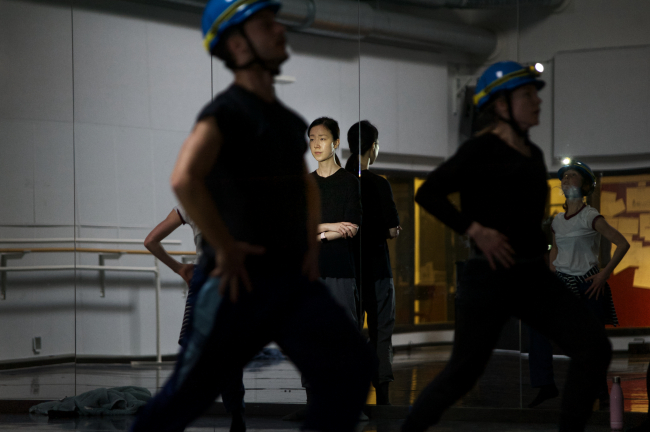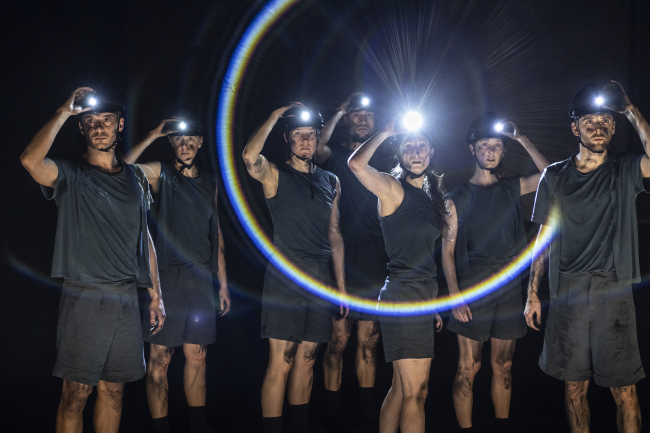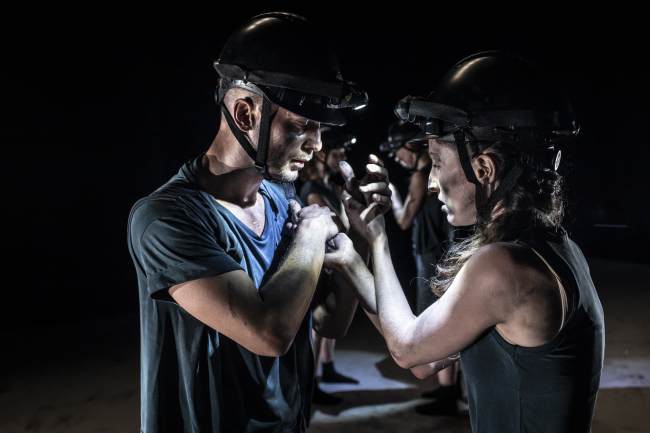Wearing dark blue-green clothes with rolled-up sleeves, seven Swedish dancers appear in a black box theater where dozens of safety helmets with headlamps are scattered around them on the gray floor. The dancers pick up seven helmets and arrange them in a line. Some call out the names of friends and family members while doing so, and others remain silent.
The accompanying music recalls a Korean traditional ritual dance. The dancers laboriously perform to the music with distinctive rhythms, and their bodies and faces soon become covered with charcoal dust as if they were being burned on an altar.
The accompanying music recalls a Korean traditional ritual dance. The dancers laboriously perform to the music with distinctive rhythms, and their bodies and faces soon become covered with charcoal dust as if they were being burned on an altar.

Up-and-coming Korean choreographer Jang Hye-rim’s latest work, “Burnt Offering,” is a contemporary dance that borrows ages-old rituals both from East and West -- from Korea’s ritual dance traditions and from the Old Testament-style sacrifices suggested in the title. Using images of these rituals, Jang attempts to portray contemporary people exhausted by their daily work routines.
The work is an homage to ordinary workers, the choreographer explained during an interview with The Korea Herald on March 13 at the Seoul Arts Center.

“Living life is like a continuous process of burning your time down to the ground. Many people might feel it is being wasted. Yet I felt there was something beautiful and sacred about the ways in which people strive to survive the repeated daily routines of labor,” Jang said. “This production is my tribute to the seemingly vain yet nonetheless meaningful time and efforts that people exert for their living.”
“Burnt Offering” premiered March 2 in Sweden and will be at the Seoul Arts Center for a three-day run March 29-31.
The work was produced between January and March when Jang was staying in Sweden as part of a chorography exchange project between the Korea National Contemporary Dance Company and Skanes Dansteater. “Seungmu,” or traditional Buddhist dance, played a critical role in her work with the Swedish dancers, Jang said.
“When I first showed one of my contemporary choreography works grounded in Korea’s traditional dance to the Skanes Dansteater dancers, they found it difficult to understand. I felt that I needed … training aids. That’s where seungmu came in,” Jang said.

Seungmu, an art form thought to have its origin in Buddhist rituals, is performed in monks’ robes with flowing sleeves and cone-shaped hats. A seungmu typically runs five, 10 or 30 minutes. The 30-minute version is regarded as the closest to the original form, according to Jang.
“Seungmu is a dance form that is very difficult to master. Some say that dancers can understand almost half of all traditional dances of Korea if they can perform a 30-minute-long seungmu piece,” Jang said.
In spite of the difficulty, Jang found seungmu was the best means of communicating with the dancers as it contained many important elements of Korean traditional dance. So seungmu became the central motif of “Burnt Offering,” Jang said.
Working on seungmu with non-Korean dancers was not an easy process, Jang recalled. But the dancers from the Malmo-based contemporary dance company were more cooperative than she could have imagined. They were open to learning from a different culture, she said.
“For instance, when I provided them with a verbal explanation about how one should breathe when doing a certain movement, they asked whether they could touch my back and front, while I was breathing, to fully grasp how they are supposed to breathe. Then they would go try on their own. For two months, they sustained such energy,” Jang said. “I was very surprised by the efforts they expended to understand their choreographer.”
Though “Burnt Offering” is based on traditional folk dance, Jang has twisted the original structure and added contemporary touches.
While seungmu usually starts with a very slow rhythm, called a “jangdan,” and ends with a fast jangdan, Jang deconstructed the original seungmu form and reorganized the rhythmic cycle to end with the slowest jangdan.
Lee Young-joo composed the music, which features computerized sounds similar to the original music used in seungmu.
As props, the charcoal and the safety helmets add a contemporary sense to the production. Charcoal is something Jang wanted to use even before she arrived in Sweden. It is a device that can effectively reveal the physicality of the notion of labor, as well as its beauty, she said.

“I wanted to express the beauty that exists on the underside of what appears to be dirty and damp,” Jang said.
“Burnt Offering” crosses genres, blending the traditional and the contemporary. “I started Korean traditional dance when I was young because I liked it. But at the same time, I was also interested in renewing tradition rather than merely preserving it,” Jang said. “Contemporary dance provides me with more freedom on the stage.”
As a choreographer rooted in Korea’s traditional dance, Jang said there was no other way to work but to use traditional dance as the base. “Even if I try something apart from Korea’s traditional dance, my works cannot hide the influence of traditional dance, which is the starting point of my career,” Jang said.
Asked how the audience should approach seemingly complicated and abstract contemporary dance pieces, Jang said, “There is no answer to that.
“It is not easy for me to watch a contemporary dance piece either. What I like about contemporary dance, however, is that you can watch it on the basis of your emotions and thoughts on a given day.
“If you are watching a contemporary piece that is relatively free of a narrative structure, for instance, you just try to feel it instead of trying to decipher the underlying meanings.”
She offered an example from “Burnt Offering.”
“For example, Riccardo (one of the seven dancers) calls out the name of his mother, who makes ice cream for a living. We all know what she does because we had talked it out in in the production process, yet the audience does not. The audience is left to imagine or put themselves into the position of those whose names have been called.”
By Shim Woo-hyun (ws@heraldcorp.com)








![[KH Explains] How should Korea adjust its trade defenses against Chinese EVs?](http://res.heraldm.com/phpwas/restmb_idxmake.php?idx=644&simg=/content/image/2024/04/15/20240415050562_0.jpg&u=20240415144419)











![[Today’s K-pop] Stray Kids to return soon: report](http://res.heraldm.com/phpwas/restmb_idxmake.php?idx=642&simg=/content/image/2024/04/16/20240416050713_0.jpg&u=)